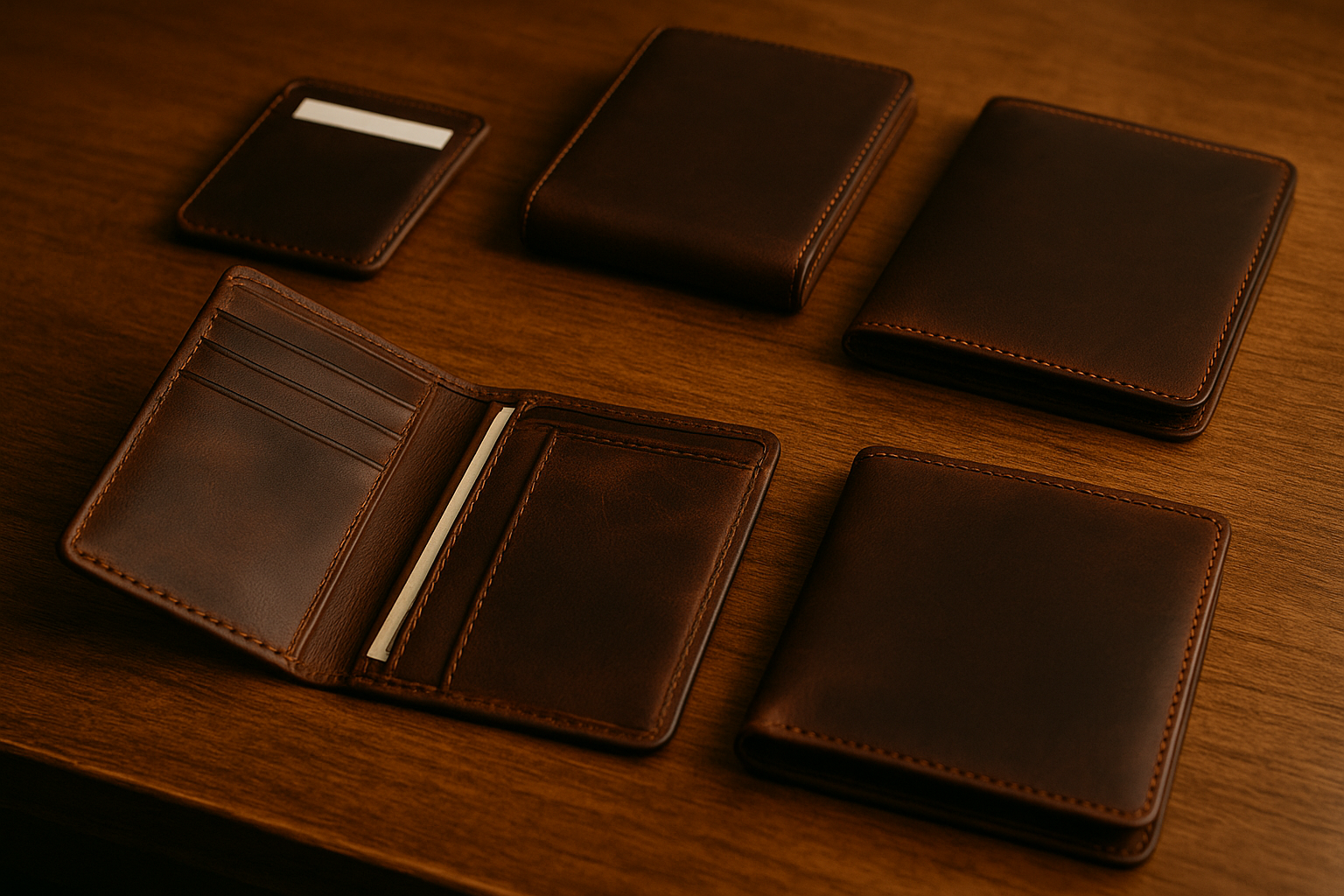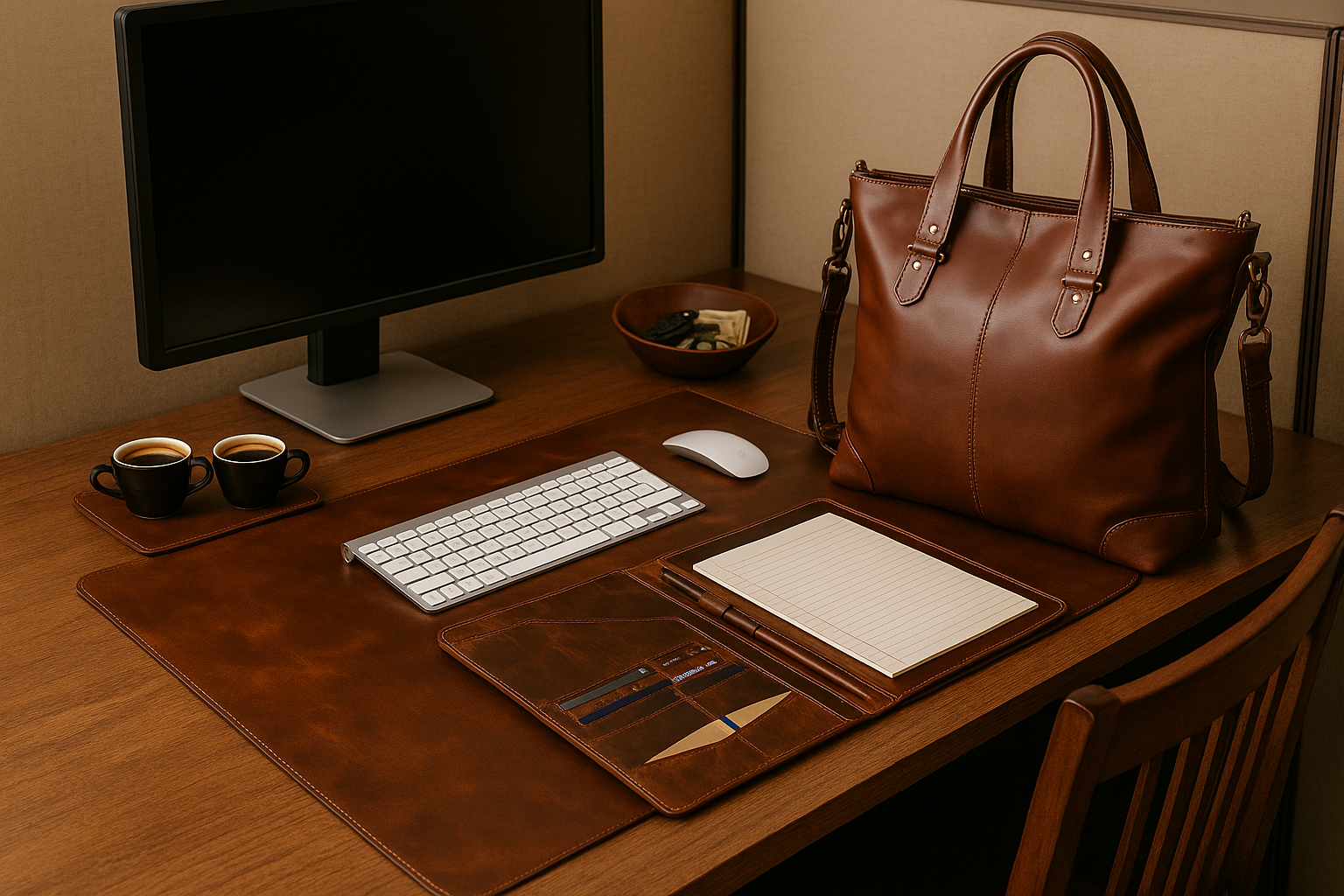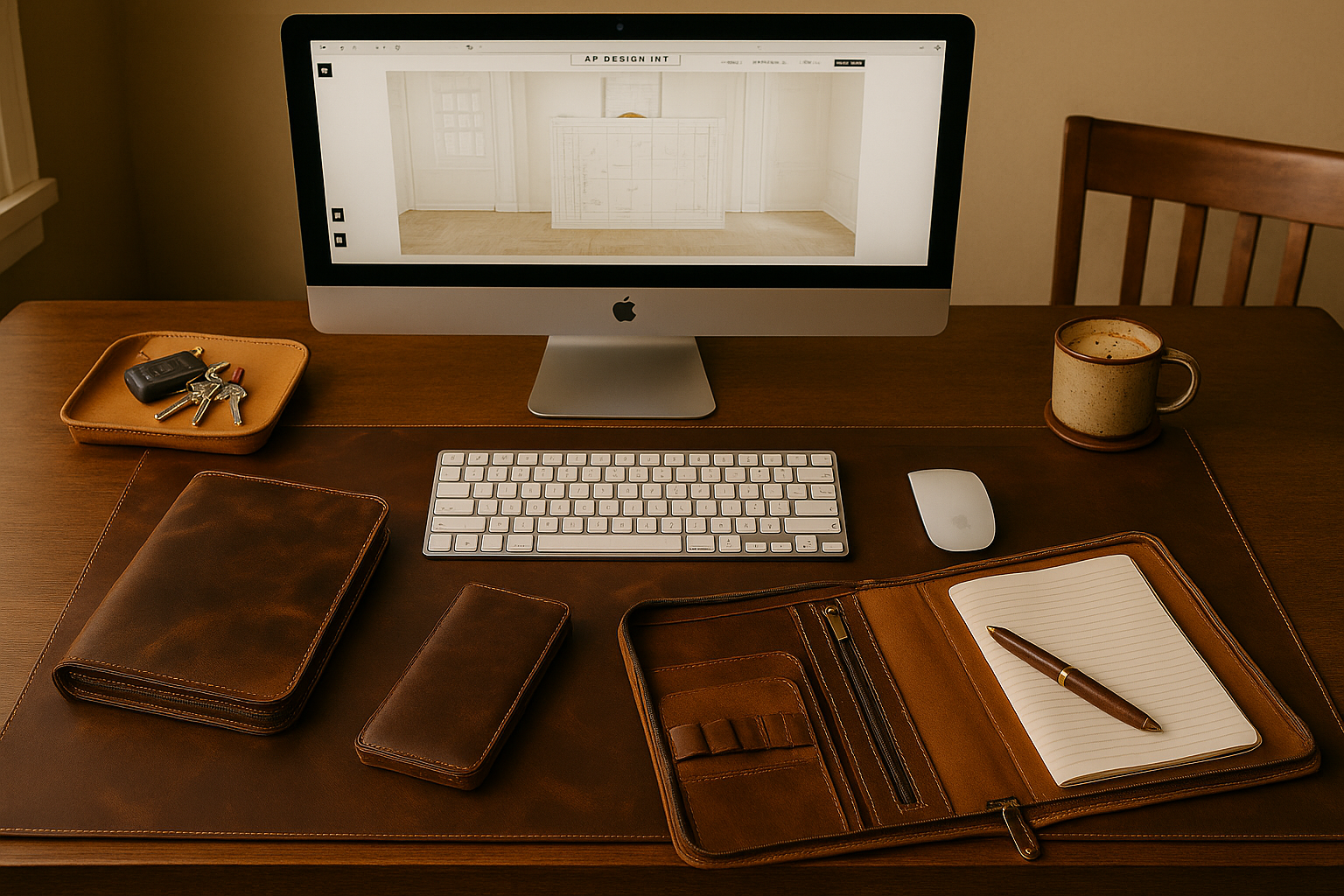
The Complete Guide to Choosing the Perfect Leather Wallet for Your Lifestyle

Your wallet is one of the most personal and frequently used accessories you own, making the decision to choose the right one both important and challenging. A quality leather wallet serves as more than just a storage device—it's a daily companion that reflects your personal style, meets your organizational needs, and adapts to your lifestyle demands while aging beautifully over years of use.
The perfect wallet balances form and function, providing sufficient organization without unnecessary bulk while complementing your aesthetic preferences and professional requirements. Understanding the various options available, from traditional bi-folds to long wallets, helps ensure your investment serves you well for years to come.
Understanding Wallet Construction and Materials
The foundation of any quality wallet lies in its construction and materials. Understanding these fundamentals helps distinguish between wallets that will serve you reliably for decades and those that might fail within months of regular use.
Leather Quality and Types
The type of leather used in wallet construction directly impacts durability, appearance, and aging characteristics. Full-grain leather represents the highest quality option, retaining the complete grain surface that develops beautiful patina while providing maximum durability and natural water resistance.
Top-grain leather offers excellent quality with a more uniform appearance, making it popular for wallets that need consistent visual presentation. This leather type accepts dyes and finishes well while maintaining good durability characteristics for daily use.
Consider how different leather types will age and develop character over time. Full-grain leathers develop rich patina that tells the story of your daily experiences, while corrected-grain options maintain more consistent appearance throughout their lifespan.
Construction Techniques
Quality wallet construction employs techniques that ensure longevity under daily stress and use. Look for reinforced stitching at stress points, particularly around card slots and fold lines where tension concentrates during opening and closing.
Edge finishing quality indicates overall construction standards and attention to detail. Well-finished edges resist fraying and maintain clean appearance over time, while poorly finished edges can unravel and create unprofessional appearance.
Hardware quality, including snaps, zippers, and metal reinforcements, should match the leather quality to ensure consistent performance throughout the wallet's lifespan. Premium hardware maintains function and appearance even after years of daily use.
Analyzing Your Wallet Usage Patterns
Choosing the right wallet requires honest assessment of your daily habits, storage needs, and usage patterns. Understanding how you actually use your wallet, rather than how you think you should use it, guides selection toward options that truly serve your lifestyle.
Card and Document Assessment
Count the cards, documents, and papers you regularly carry to determine minimum storage requirements. Include credit cards, identification, insurance cards, business cards, receipts, and any other items that consistently occupy wallet space.
Consider storage growth over time, as most people accumulate additional cards and documents gradually. Choose wallets with slight excess capacity to accommodate this natural expansion without requiring premature replacement.
Analyze which items you access frequently versus those stored for emergencies. Frequently accessed items should have prime real estate in easily accessible locations, while emergency items can occupy less convenient storage areas.
Cash Handling Preferences
Assess your cash usage patterns to determine appropriate bill storage requirements. Some users carry minimal cash and prefer compact bill compartments, while others need substantial cash storage with organization for different denominations.
Consider regional currency characteristics that might influence wallet design preferences. Larger bills or multiple currencies might require specialized storage solutions not found in standard wallet designs.
Evaluate whether you need coin storage capabilities, as this significantly impacts wallet size and design options. Traditional coin purses add bulk but provide secure small change storage, while money clips offer minimal bulk with limited coin capacity.
Lifestyle-Based Wallet Selection
Different lifestyles demand different wallet characteristics, from professional requirements to active outdoor pursuits. Matching wallet features to lifestyle demands ensures optimal performance and satisfaction over time.
Professional and Business Requirements
Business professionals often need wallets that project competence while organizing essential professional materials. A slim leather wallet maintains professional appearance in suit pockets while providing organized storage for business cards, credit cards, and identification.
Consider how your wallet appears during business interactions, from client meetings to networking events. Professional wallets should complement rather than distract from business presentation, maintaining clean lines and quality appearance.
Business travel requirements might influence wallet selection, with considerations for international cards, multiple currencies, and security features that protect against theft or electronic skimming.
Active and Casual Lifestyles
Active lifestyles require wallets that secure contents during movement while resisting wear from physical activity. Look for secure closure systems, reinforced construction, and materials that handle moisture and temperature variations.
Consider pocket placement preferences for different activities. Front pocket carry might be more secure and comfortable during physical activities, requiring slimmer wallet profiles than traditional back pocket designs.
Evaluate durability requirements for your activity level. Frequent outdoor activities, sports participation, or physical work might require more robust construction than sedentary professional environments.
Fashion-Forward Preferences
Style-conscious individuals often prioritize aesthetic appeal alongside functional requirements. Consider how wallet design complements your overall style aesthetic, from minimalist modern to classic traditional approaches.
Color and texture choices should harmonize with your wardrobe and accessory preferences. Neutral colors offer maximum versatility, while distinctive options can serve as style statements or conversation pieces.
Balance fashion preferences with practical requirements to ensure your stylish wallet also serves daily functional needs effectively. Beautiful wallets that don't work well often end up replaced quickly.
Size and Profile Considerations
Wallet size significantly impacts daily comfort, pocket compatibility, and carrying convenience. Understanding size implications helps avoid common problems like excessive bulk or insufficient storage capacity.
Pocket Compatibility
Different clothing styles accommodate different wallet sizes and shapes. Slim-fit clothing requires thinner wallet profiles, while traditional cuts can accommodate larger wallets without creating unsightly bulges or discomfort.
Consider seasonal clothing variations that might affect wallet compatibility. Summer lightweight clothing might require smaller wallets than winter jacket pockets can accommodate.
Evaluate front versus back pocket preferences, as each location has different size and security implications. Front pocket carry often requires slimmer profiles but offers better security and comfort during sitting.
Bulk Management
Excessive wallet bulk creates discomfort and unprofessional appearance while potentially causing back problems from prolonged sitting on thick wallets. Balance storage capacity with reasonable thickness limits for comfortable daily carry.
Consider how wallet thickness increases with contents, ensuring your chosen wallet maintains reasonable bulk even when fully loaded with typical daily items.
Evaluate organization features that reduce bulk while maintaining capacity. Well-designed card slots and compartments can store more items in less space than poorly organized alternatives.
Traditional Wallet Styles and Their Applications
Understanding classic wallet styles helps identify options that match your preferences and requirements. Each style offers distinct advantages and limitations that suit different users and situations.
Bi-fold Wallets
Bi-fold wallets represent the most common and versatile wallet style, folding in half to create compact storage with good organization. They typically offer multiple card slots, bill compartments, and optional coin storage while maintaining reasonable size.
Traditional bi-fold designs work well for users who carry moderate amounts of cards and cash while preferring familiar organization patterns. They fit comfortably in most pockets while providing easy access to frequently used items.
Consider bi-fold variations like multiple bill compartments, transparent ID windows, or additional card storage that might enhance functionality for your specific needs.
Tri-fold Wallets
Tri-fold wallets maximize storage capacity by folding into three sections, providing extensive card and document storage in compact footprints. They work well for users who carry many cards but prefer smaller wallet dimensions.
The additional fold can create thickness that some users find uncomfortable, particularly for back pocket carry. Evaluate whether the extra storage capacity justifies the increased bulk for your usage patterns.
Quality tri-fold construction requires careful attention to fold lines and stress points that experience additional wear from the extra folding mechanism.
Long Wallets and Money Clips
Long wallets offer extensive storage without folding, keeping bills flat and providing generous card organization. They work particularly well for users who carry cash frequently or need extensive card storage.
Long wallets require larger pockets or bag carry, making them less suitable for tight clothing or minimal carry preferences. However, they excel in situations where organization and capacity take priority over compactness.
Money clips provide minimal bulk with basic card and cash storage, appealing to users who prefer streamlined carry with essential items only. They work best for users with established minimal carry preferences.
Modern Wallet Innovations
Contemporary wallet design incorporates modern requirements like RFID protection, smartphone integration, and enhanced security features while maintaining traditional leather aesthetics and quality.
RFID Protection Features
RFID-blocking technology protects credit cards and identification from electronic skimming, providing security against digital theft methods. This feature becomes increasingly important as contactless payment technology expands.
Evaluate whether RFID protection suits your security preferences and card usage patterns. Users with multiple contactless cards or frequent travel might benefit more from this protection than occasional users.
Ensure RFID protection doesn't interfere with intended contactless usage, as some blocking technologies can prevent legitimate contactless transactions when desired.
Modular and Expandable Designs
Some modern wallets offer modular construction that adapts to changing storage needs over time. These designs might include removable card holders, expandable compartments, or interchangeable components.
Consider whether modular features align with your usage patterns or represent unnecessary complexity for your needs. Some users appreciate adaptability, while others prefer simple, consistent organization.
Evaluate the long-term viability of modular systems, ensuring replacement components remain available and compatible as designs evolve.
Color and Aesthetic Choices
Wallet color and aesthetic choices impact both personal satisfaction and professional appropriateness while influencing aging characteristics and maintenance requirements.
Classic Color Options
Traditional brown and black leather colors offer maximum versatility and professional appropriateness while aging gracefully over time. These colors complement most wardrobes and business environments without requiring special coordination.
Brown leather develops rich, complex patina that many users find appealing, while black maintains more consistent appearance over time. Consider which aging characteristics align with your aesthetic preferences.
Evaluate how color choices might limit or enhance wardrobe compatibility, ensuring your wallet complements rather than conflicts with your typical clothing choices.
Distinctive and Personal Colors
Unique colors or specialty leathers can express personal style while creating distinctive appearance that reflects individual preferences. Consider whether distinctive choices will maintain appeal over the wallet's expected lifespan.
Specialty colors might require additional care or have different aging characteristics than traditional options. Research maintenance requirements and aging patterns before committing to unusual color choices.
Balance personal expression with practical considerations like professional appropriateness and long-term aesthetic appeal.
Budget Considerations and Value Assessment
Wallet investment decisions should balance immediate budget constraints with long-term value considerations, recognizing that quality wallets often provide better cost-per-use over their lifespan.
Price vs. Quality Analysis
Quality leather wallets represent investments that can serve users for decades when properly cared for, making higher initial costs often more economical than frequent replacements of inferior products.
Evaluate construction quality, material grades, and warranty provisions when assessing value propositions. Premium features and materials might justify higher costs for users who will benefit from enhanced durability and performance.
Consider your replacement patterns and typical wallet lifespan when evaluating investment levels. Users who frequently lose or damage wallets might prefer more modest investments than those who maintain accessories carefully.
Value-Added Features
Assess whether premium features like specialized organization, security technologies, or enhanced materials provide value that justifies additional cost for your specific usage patterns.
Consider the total cost of wallet ownership, including maintenance products, potential repairs, and replacement frequency when evaluating different price points and quality levels.
Evaluate warranty and repair services that might extend wallet life and provide additional value beyond initial purchase price.
Maintenance and Longevity Planning
Proper wallet care significantly extends lifespan while maintaining appearance and functionality. Understanding maintenance requirements helps preserve your investment and ensure continued satisfaction.
Daily Care Routines
Develop simple daily habits that protect wallet condition, including regular cleaning of debris, rotating card positions to prevent permanent impressions, and monitoring for developing wear patterns.
Empty and air out wallets periodically to prevent moisture accumulation and allow leather to breathe. This practice helps prevent mold, mildew, and premature deterioration from trapped moisture.
Monitor wallet condition regularly to identify developing issues early, when preventive care can address problems before they require expensive repairs or replacement.
Long-term Preservation
Plan for periodic conditioning and professional care that maintains leather quality and extends wallet life. Quality leather wallets can often be restored to near-new condition with proper professional treatment.
Consider seasonal care routines that address environmental stresses and usage variations throughout the year. Summer humidity and winter dryness might require different care approaches.
Evaluate repair versus replacement decisions as wallets age, considering sentimental value, restoration costs, and performance requirements in your decision-making process.
Gift Considerations and Personal Preferences
Wallets make popular gifts, requiring consideration of recipient preferences, lifestyle requirements, and personal tastes that might differ from your own experience and preferences.
Understanding Recipient Needs
Observe the recipient's current wallet usage patterns, noting card carrying habits, cash usage, and style preferences that should influence gift selection. Avoid assuming your preferences match theirs.
Consider the recipient's lifestyle, profession, and daily activities when selecting wallet features and characteristics. Business professionals might need different features than students or retirees.
Evaluate whether personalization options like monogramming or custom features would enhance the gift's meaning and personal connection for the recipient.
Safe Gift Selection Strategies
When uncertain about specific preferences, choose classic styles and neutral colors that offer maximum versatility and broad appeal. Traditional brown or black leather wallets rarely disappoint recipients.
Consider gift sets that include wallet care products, providing everything needed for proper maintenance while demonstrating thoughtfulness about long-term wallet care.
Include gift receipts or exchange policies that allow recipients to adjust their selection if the initial choice doesn't perfectly match their preferences or needs.
Breaking In and Personalizing Your New Wallet
New leather wallets require break-in periods that soften the leather and adapt the wallet to your specific usage patterns. Understanding this process helps optimize your wallet's performance and longevity.
Initial Break-in Process
New leather wallets often feel stiff and resist easy opening and closing. Gradual use with progressive loading allows leather to soften naturally while developing appropriate flexibility for comfortable daily use.
Start with essential cards and documents only, gradually adding additional items as the wallet softens and adapts to your usage patterns. This approach prevents overstretching during the critical break-in period.
Be patient with initial stiffness and resistance, as quality leather requires time to develop the suppleness and comfort that makes premium wallets so enjoyable to use.
Developing Personal Organization
Establish consistent organization patterns that optimize wallet functionality for your specific needs and preferences. Consistent card placement reduces search time while protecting frequently accessed items.
Experiment with different organization approaches during the break-in period to identify systems that work best for your daily routines and access patterns.
Consider seasonal adjustments to wallet contents and organization that accommodate changing requirements throughout the year.
Conclusion: Making the Right Wallet Investment
Choosing the perfect leather wallet requires balancing personal preferences with practical requirements while considering long-term value and satisfaction. Quality leather wallets reward careful selection with years of reliable service, developing character and beauty that enhance rather than diminish over time.
Remember that your wallet serves as a daily companion that reflects your personal style while meeting practical needs. Take time to evaluate your actual usage patterns, lifestyle requirements, and aesthetic preferences rather than choosing based on assumptions or others' recommendations.
Whether you prefer a classic bi-fold design, an organized long wallet, or a distinctive western-style piece, the key lies in choosing quality construction and appropriate features that match your daily reality rather than idealized preferences.
Invest in quality materials and construction that will serve you well over years of daily use, and commit to proper care and maintenance that preserves your investment. A well-chosen leather wallet becomes more than an accessory—it becomes a trusted daily companion that improves with age while reliably supporting your daily activities and professional presentation.
For more guidance on wallet selection or to explore our complete collection of quality options, visit our leather goods collection or consult our care and warranty information to understand the support available for your investment.




